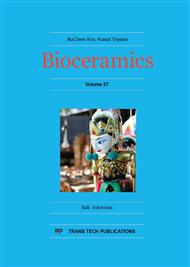p.27
p.32
p.36
p.40
p.45
p.51
p.57
p.60
p.69
Novel Bioceramic Production via Mechanochemical Conversion from Plate Limpet (Tectura scutum) - Shells
Abstract:
Calcium phosphates are very important biomaterials for orthopaedic and dental applications. Hydroxyapatite (HA) is one of the important phases used for grafting. Those are produced from synthetic and natural sources with various methods. Especially nano-bioceramics can be produced through calcitic and aragonitic structures (i.e. mussel shells, sea snail shells, land snail shells and sea urchin shells). The plate limpet shells were used. The plate limpet is a gastropod, a soft-bodied invertebrate (an animal without a backbone) that is protected by a very hard, flattened conical shell. In this study the Plate Limpet (Tectura scutum) shells were obtained from a local gift store in Istanbul. The habitation of these limpets broadens from south Alaska down to California - Mexico. First the exact CaCO3 content was measured with thermal analysis (DTA/TGA). Here in this study agitation was carried out on a hot-plate (i.e. mechano-chemical processing). First the temperature was set at 80 °C for 15 min. Then equivalent amount to CaO H3PO4 was added dropwise for HA phase formation and the reaction was set on a hotplate for 8 hours. The dried sediments HA part was divided into 2 groups. One group was sintered to 835 °C and second group to 855 °C. Here x-ray diffraction and scanning electron microscope (SEM) studies were performed. From the study various HA phases and TCP phases were obtained. A previous study done with Atlantic Deer Cowrie encourages nanobioceramic production from natural sources. This study proposes that mechanochemical agitation with very simple way for producing nano-sized calcium phosphates for future bioengineering scaffold applications.
Info:
Periodical:
Pages:
45-50
Citation:
Online since:
May 2016
Price:
Сopyright:
© 2016 Trans Tech Publications Ltd. All Rights Reserved
Share:
Citation:


